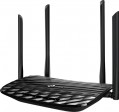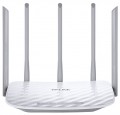Data input (WAN-port)
Methods for connecting to the Internet (or other external network, such as in
bridge mode) supported by the device.
The classic, most common version of such a connection nowadays is
LAN (Ethernet), but this is not limited to this. A wired connection can also be made via
ADSL or
SFP fiber, and wirelessly via mobile networks (using a
SIM card,
SIM card 5G or an external modem for
3G or
4G), as well as via Wi-Fi. Here is a more detailed description of each option:
— Ethernet (RJ45). Classic wired connection via a network cable via an RJ-45 connector. Also known as "LAN", although this designation is not entirely correct. Nowadays, it is one of the most common methods of wired Internet connection, and is also widely used in local networks. This is due to the fact that the speed of Ethernet is actually limited only by the capabilities of network controllers; at the same time, even the simplest modules support up to 100 Mbps, and in advanced equipment this value can reach 10 Gbps.
— ADSL. A technology primarily used for wired Internet connections over existing landline telephone lines. This is its main advantage — you can use ready-made lines without fiddling with laying numerous addi
...tional wires; at the same time, ADSL works independently of telephone calls and does not interfere with them. At the same time, the speed of such a connection is noticeably lower than via Ethernet — even in advanced equipment it does not exceed 24 Mbps. In addition, ADSL traffic is distributed asymmetrically: full speed is achieved only when working for reception, data transmission speed is much lower, which creates problems for video communication and some other tasks. So nowadays, ADSL is gradually being replaced by more advanced standards, although the complete disappearance of this technology is still far away.
— Wi-Fi. Connect to an external data source via Wi-Fi. By definition, this format of operation is used by Wi-Fi adapters (see "Device type"), as well as by most MESH equipment. (However, if the MESH system package includes both nodes and the main control device for them, then the WAN input can be specified for the control device, and often this is not Wi-Fi). Also, this type of data input can be provided in other types of equipment — in particular, routers and access points (for example, to work in bridge or repeater mode).
— 3G modem (USB). Internet connection via 3G mobile network using a separate external modem connected to the USB port. Most often, we are talking about UMTS networks (the development of GSM mobile communications), the most common in Europe and the post-Soviet space; however, it may also be possible to use modems for CDMA networks (EV-DO technology). These nuances, as well as compatibility with specific modem models, need to be clarified separately. However, anyway, 3G may be a good option for situations where a wired Internet connection is difficult or impossible, such as in the private sector. In addition, some Wi-Fi devices with this feature are equipped with autonomous power supplies and can even be used on the go. The data transfer speed of 3G is close to broadband wired connection (from 2 to 70 Mbps with a normal signal, depending on the specific technology); however, it is less than in 4G networks (see below), but 3G coverage is more extensive, and equipment for this standard is cheaper.
— 4G (LTE) modem (USB). Internet connection via 4G mobile network (LTE) using a separate external modem connected to the USB port. The main features are similar to the 3G connection described above, adjusted for the fact that in this case more advanced fourth-generation networks are used. The data transfer rate in such networks reaches about 150 Mbps; they are not as widespread as 3G-connection, but soon we can expect a change in the situation. In addition, it should be noted that in Europe and the post-Soviet space, LTE networks are usually deployed on the basis of 3G UMTS and GSM networks; so in the absence of full-fledged 4G coverage, modems for such networks can work according to the 3G and even GSM standard.
— SIM card. Connecting to the Internet via a mobile network using a mobile operator's SIM card installed directly in the device. The specific type of supported networks depends both on the capabilities of the router and on the conditions of a particular mobile operator; however, all such equipment is compatible with at least 3G networks, and often 4G as well. The features of these networks are described in detail above (you can also read about the advantages of a mobile Internet connection there). This option is convenient because it allows you to do without a separate USB modem — you just need to purchase a SIM card, the cost of which is negligible. In addition, the use of "sim cards" has a positive effect on compactness and ease of carrying. On the other hand, the built-in mobile communication module significantly affects the overall cost — and you will have to pay for it anyway (whereas a model with support for external modems does not have to be bought immediately with a modem, such devices usually allow wired connection). Therefore, you should pay attention to this option if you initially plan to connect to the Internet through mobile networks.
- SIM card (5G). The ability to operate Wi-Fi equipment in high-speed 5G mobile networks with a peak bandwidth of up to 20 Gbps for reception and up to 10 Gbps for data transmission. Implemented via a SIM card with appropriate 5G support. This standard reduces power consumption compared to previous versions, and it also uses a number of complex solutions aimed at improving the reliability and overall quality of communication - in particular, multi-element antenna arrays (Massive MIMO) and beamforming technologies (Beamforming).
— SFP (optics). Connection via fiber optic cable of the SFP standard. Such a connection can be carried out at high speeds (measured in gigabytes per second), and the fiber, unlike the Ethernet cable, is practically insensitive to external interference. On the other hand, the support of this standard is not cheap, and its capabilities are unnecessary for domestic use. Therefore, SFP is found mainly in professional-level Wi-Fi devices.Wireless speed 2.4 GHz
The maximum speed provided by the device when communicating wirelessly in the 2.4 GHz band.
This range is used in most modern Wi-Fi standards (see above) - as one of the available or even the only one. The theoretical maximum for it is 600 Mbit. In reality, Wi-Fi at a frequency of 2.4 GHz is used by a large number of client devices, from which congestion of data transmission channels emerges. Also, the number of antennas affects the speed performance of the equipment. It is possible to achieve the speed declared in the specification only in an ideal situation. In practice, it can be noticeably smaller (often by several times), especially with an abundance of wireless technology simultaneously connected to the equipment. The maximum speed at 2.4 GHz is specified in the characteristics of specific models to understand the real capabilities of Wi-Fi equipment. As for the numbers, according to the capabilities in the 2.4 GHz band, modern equipment is conditionally divided into models with speeds
up to 500 Mbit inclusive and
over 500 Mbit.
WAN
The WAN port characterizes the ability of the device to receive a wired signal. There may be models with both one port and
two WAN ports, and in rare cases, more connected providers. Such an expanded number of WAN connectors affects the cost and, accordingly, is found in more part among professional-level routers.
In terms of speed, when choosing a device, the priority is the speed of the output LAN port or Wi-Fi. However, faster WAN ports (
1 Gbps,
2.5 Gbps,
5 Gbps,
10 Gbps) allow you to divide the load on several outputs at once without reducing speed performance, as may be the case with
WAN port 100 Mbps.
LAN
In this case, LAN means standard network connectors (known as RJ-45) designed for wired connection of LAN devices — PCs, servers, additional access points, etc. The number of ports corresponds to the number of devices that can be directly connected to wired equipment. way.
In terms of speed,
100 Mbps (Fast Ethernet) and
1 Gbps (Gigabit Ethernet) are the most popular options today. At the same time, thanks to the development of technology, more and more gigabit devices are being produced, although in fact this speed is critical only when transferring large amounts of information. At the same time, some models, in addition to the standard speed of the main LAN ports, may have
a 2.5 Gbps, 5 Gbps and even 10 Gbps LAN port with increased bandwidth.
Antenna type
—
External. Outdoor antennas tend to be larger than indoor antennas, and they usually have swivel mounts that allow the rod to be placed in the optimal position, regardless of the position of the device itself. All this has a positive effect on signal strength. In addition, there are removable external antennas — if desired, they can be replaced with more powerful ones. The main disadvantage of this option can be called bulkiness.
— Internal. Antennas located inside the case are considered less advanced than external ones. In most cases, they are smaller, and the performance depends on the position of the device (although many manufacturers use technologies to compensate for this effect). At the same time, equipment with
internal antennas has a neat appearance without unnecessary protruding parts.
— External / internal. The presence in the device at once of both types of antennas described above (in this case, there may be more than one of those and others). The presence of several antennas improves the quality of communication, but if they are all external, the device may turn out to be too bulky. Therefore, in some models of routers, a compromise is used: part of the antennas is hidden in the case, which has a positive effect on compactness and appearance.
MU-MIMO
Device support for
MU-MIMO technology - multi-user multi-threaded I / O.
Communication in multiple streams is implemented through the use of multiple antennas on both the transmitting and receiving device. This allows you to increase the bandwidth of the channel, as well as improve the overall quality and stability of the connection. And the term "multi-user" usually means that Wi-Fi equipment is able to simultaneously work with several external devices that support multi-streaming (MIMO). The only exceptions are Wi-Fi adapters (see "Device type") - they are more about the ability to interact with the router / access point as efficiently as possible, which also uses MU-MIMO.
2.4 GHz antennas
The total number of antennas in the router that are responsible for communication in the 2.4 GHz band. For details about the number of antennas, see "Total antennas", about the range — "Frequency range".
5 GHz antennas
The total number of antennas in the router that are responsible for communication in the 5 GHz band. For details about the number of antennas, see "Total antennas", about the range — "Frequency range".
Signal strength 2.4 GHz
The power of the transmitter installed in the equipment when operating in the 2.4 GHz band (see "Frequency Band").
This parameter directly affects the overall power and, accordingly, the communication efficiency. For more on this, see p. "Transmitter power" above, but here we separately emphasize that high power is not always required, and in some cases it is frankly harmful.

